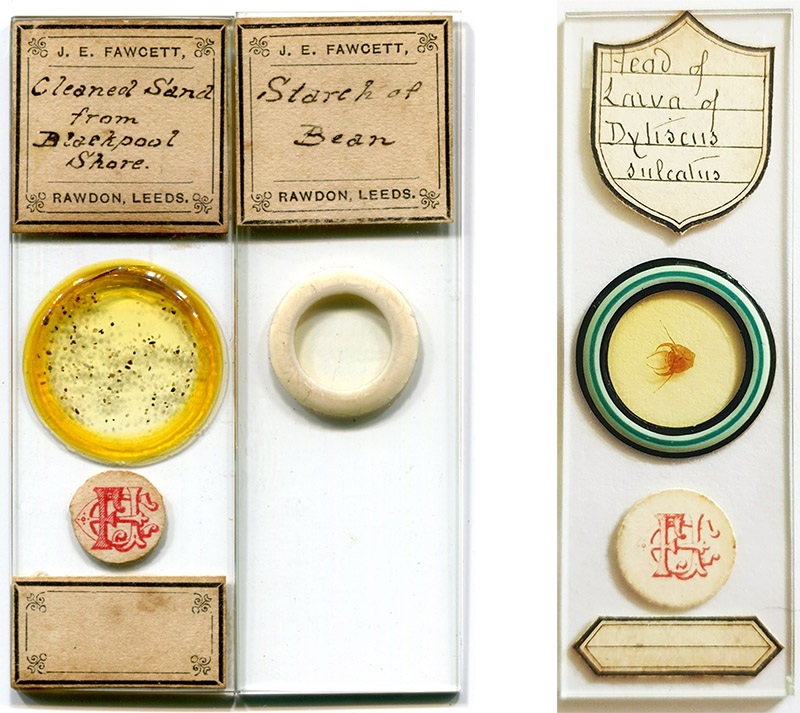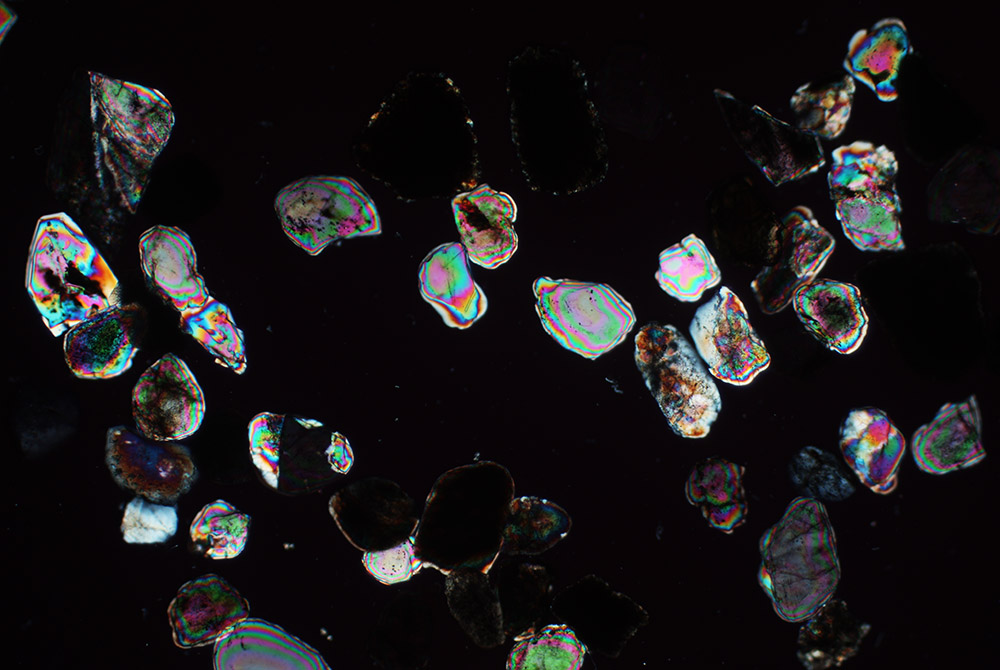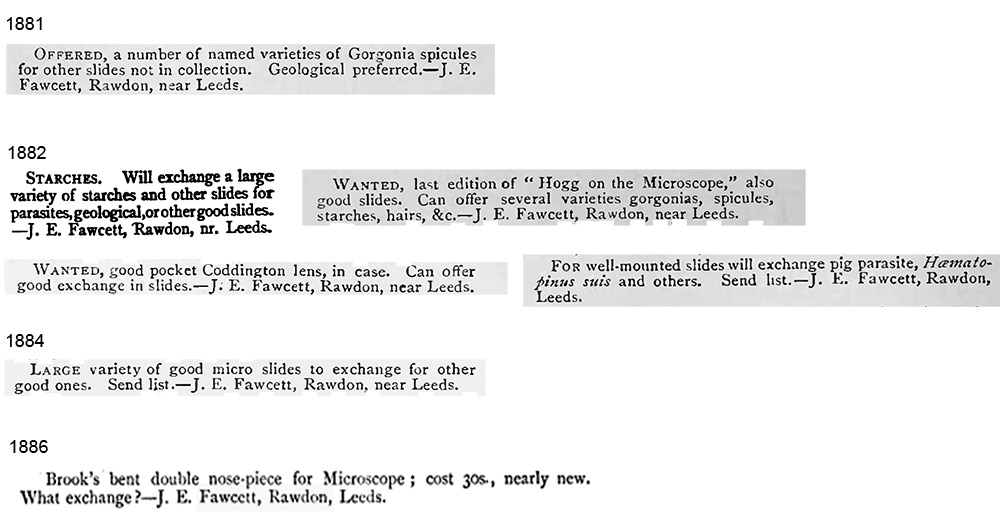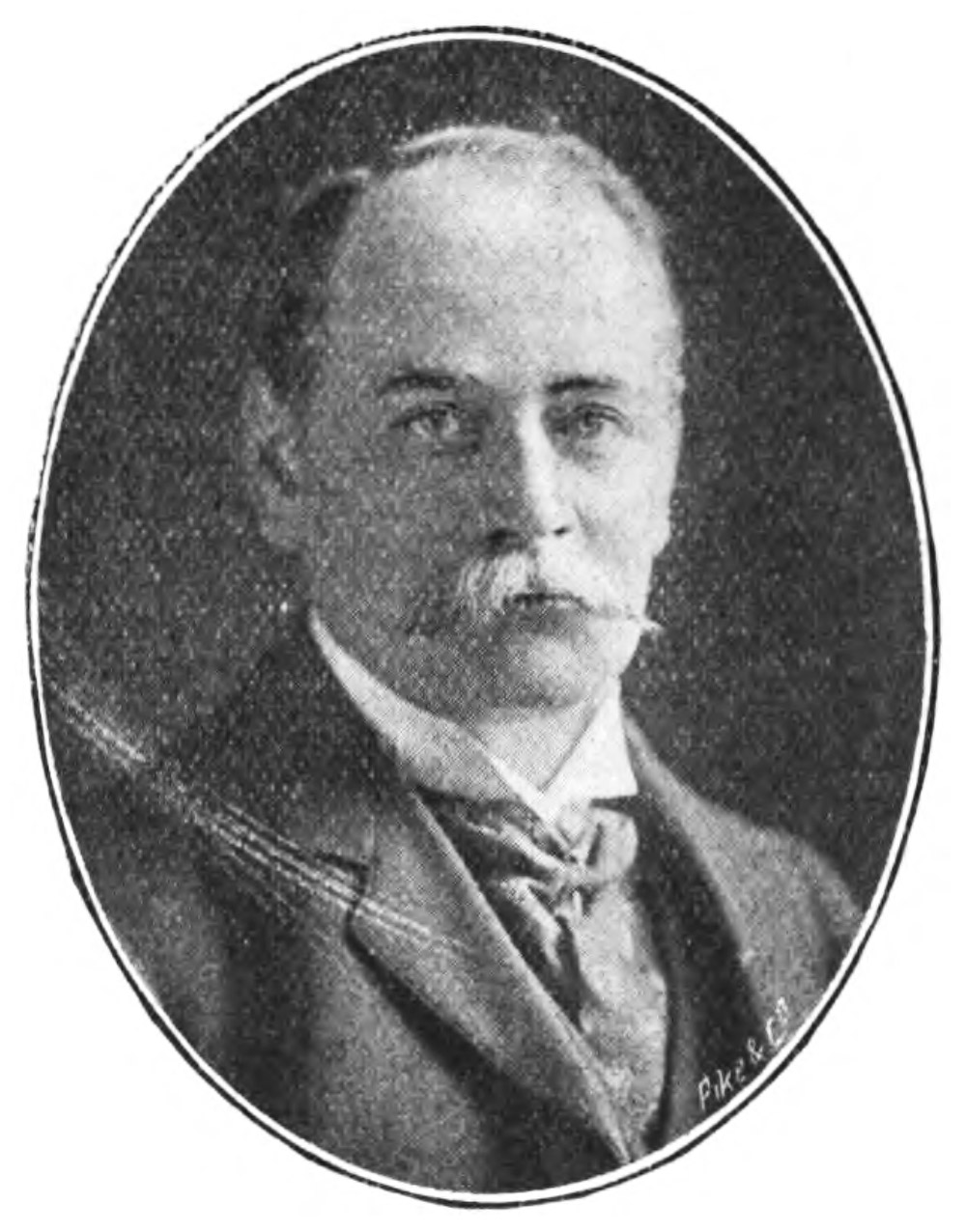John Edward Fawcett, 1855 - 1918
by Brian Stevenson
last updated July, 2021
J.E. Fawcett was a wealthy businessman, heir to the wool business that had been started by his grandfather. Fawcett lived in Rawdon, Yorkshire, although he also had an address in the nearby city of Bradford: he served as Lord Mayor of Bradford in 1907.
Fawcett appears to have become interested in microscopy around 1880, and advertised slides for exchange during the early 1880s (Figures 1-4). He joined the Royal Microscopical Society in 1883.

Figure 1.
(Left) Two microscope slides that were made by J.E. Fawcett, both with his custom-printed labels. He advertised to exchange slides of plant starches in 1882 (see Figure 4), and this example likely dates from that period. (Right) A mount from professional slide-maker J.C. Tempère (1847-1926), bearing a label with Fawcett's monogram, indicating that it was once in his collection. Images from the author's collection or adapted for nonprofit, educational purposes from an internet auction site.

Figure 2.
"Sand from Blackpool Shore", mounted ca. 1882 by J.E. Fawcett (see Figure 1). Photographed with a 3.5x objective lens, crossed polarizing filters, and C-mounted digital SLR camera, on a Leitz Ortholux II microscope.

Figure 3.
"Starch of Bean", mounted ca. 1882 by J.E. Fawcett (see Figure 1). Photographed with a 10x objective lens, crossed polarizing filters, and C-mounted digital SLR camera, on a Leitz Ortholux II microscope.

Figure 4.
Microscope-associated exchange offers from J.E. Fawcett, published in "Hardwicke's Science-Gossip", "The Northern Microscopist and Microscopical News", and "The Scientific Enquirer". I did not locate any exchange offers after 1886.
John was the eldest son of Richard and Sarah Fawcett, born in Bradford on August 27, 1855. Richard was described in the 1861 census as a "wool merchant, employing 12 men and boys". The family had grown steadily, with six children (John's elder two sisters, and two younger brothers and a younger sister). The household was supported by a cook, a house maid, a governess, and a wet nurse for the newborn girl.
A 1904 book on the Bradford area, Illustrated Rambles from Hipperholme to Tong by James Parker, included biographical sketches of important people in the vicinity. He wrote this about J.E. Fawcett: "John Edward Fawcett is grandson of Richard Fawcett, of Holme Mill, and son of Richard Fawcett, J.P., who was a wool merchant and for some time chairman of the Bradford Banking Company. Educated at the Bradford Grammar School and St. Peter's School, York, he is chairman of the Wool Trade Section of the Bradford Chamber of Commerce, J.P. for the city, member of the Council of the Bradford Philosophical Society, and Fellow of the Royal Microscopical Society, governor of the Bradford Grammar School, local hon. sec. of the British Association for the Advancement of Science, in 1900, director of the Bradford Exchange Company, on the Executive Committee of the Bradford Cartwright Memorial Exhibition, hon. sec. of the Victoria Children's Convalescent Fund of the Bradford Tradesmen's Benevolent Institution, member of the Tuberculosis Committee and of the Committee for the Prevention of Cruelty to Children, of the Deaf and Dumb Institution, of the Charity Organisation, the Discharged Prisoners' Aid Society, vice-president of the Children's Hospital, and formerly on the Board of the Royal Infirmary and the Woodlands Convalescent Home. He is connected with several branches of Freemasonry and a member of the Civil Engineer Lodge of Oddfellows. Mr. Fawcett is the principal of the firm of Messrs. Richard Fawcett and Sons, wool merchants, Canal Road, Bradford".
John Fawcett married Mary Alice Kelly on April 16, 1879. They promptly had five children together. As with his parents' household, they enjoyed the comforts of cooks, maids, and nurses.
It was shortly after his marriage that J.E. Fawcett was first recorded as being involved with microscopy (Figure 4). His first known exchange offer, from 1881, sought "other slides not in collection", implying that he had already acquired a good number of mounts. In 1882, he offered to provide "a large variety of starches and other slides" and "pig parasites", indicating that he was a competent mounter by that time. The slide of bean starch shown in Figure 1 probably dates from this time.
Fawcett was elected to membership in the Royal Microscopical Society in 1883. He remained a member through at least 1908.
Also in 1883, Fawcett published an article on "mounting with wax cells" in The Microscopical News and Northern Microscopist:
"In mounting 'dry', I have invariably found a large proportion of my preparations spoilt from one or other of two causes.
The most difficult one to contend with was the running in of the cement used to fasten the cover-glass and seal the slide up. The other cause was the dampness often shewn after every precaution had been taken to have both object and cell thoroughly dry before applying the cover-glass.
After trying every receipt I could find, I determined to try an idea of my own, and which, after many months' use, has answered the purpose remarkably well. No doubt others have found the same difficulties, so I am tempted to give my experience.
I found a remedy for running in; it was invariably with a cement that caused the dampness, and vice versa, so I determined to bring wax to my aid. My process is to get a spirit lamp and place it under a dish supported on a retort stand. Into the dish I pour white wax or bees wax, and melt it. It requires making very hot, and the lamp to be left continually under the dish. If the slide is to be opaque, I cut a piece of black paper to about the size of the cell to be made, and attach it to the slip. I then put it on the turn-table, and build up the cell with the hot wax. Of course it is allowed to overlap the paper background and the glass, and thus make a neat cell. It has the advantage of being built up to any thickness at once. There is also no untidiness of the paper not fitting the bottom of the ordinary vulcanite cell, or if it is placed on the undersides of it, being scratched off. Then again, if the background is put at the back of the glass slip, it is invariably bright instead of dull. When the slide is dry and ready for sealing up, all that is necessary is, place the cover on it and put it once more on the turn-table, when one turn, with the application of the wax brush, is sufficient to make it a permanent mount. It can then be finished with the usual varnishes.
I have described it for opaque dry mounts, but the process can be equally well used with transparent dry mounts.
I also use the wax to help to fill up the sides of balsam cell mounts, between the closing cement and the finishing varnish.
In adopting this plan, the wax must be kept very hot, and the brush should be left in it when not in use.
I have never seen this process described, but since I found it out I have told many of my friends of it; they have all found it a great success".
Fawcett was also active in his local microscope club, the Bradford Microscopical Society. He served in several offices over the years.
John's wife, Mary, died in 1915. He followed her on June 21, 1918. He left an estate of well over £50 000.

Figure 5.
John Edward Fawcett, from the 1904 book, "Illustrated Rambles from Hipperholme to Tong".
Resources
England census and other resources, accessed through ancestry.com
Fawcett, J.E. (1883) Mounting in wax cells, The Microscopical News and Northern Microscopist, pages 153-154
Hardwicke's Science-Gossip (1881) Exchange offer from J.E. Fawcett, Vol. 17, page 192
Hardwicke's Science-Gossip (1882) Exchange offers from J.E. Fawcett, Vol. 18, pages 24, 48, and 216
Hardwicke's Science-Gossip (1884) Exchange offer from J.E. Fawcett, Vol. 20, page 144
Journal of the Royal Microscopical Society (1889) Fellows: "1883 Fawcett, John Edward. Low Royd, Apperley-bridge, near Leeds", page l
The Municipal Journal (1907) The New Mayors, elections in London and provinces, "Bradford (Lord Mayor).- Mr. J. E. Fawcett", Vol. 16, page 974
The Naturalist (1884) The second annual meeting of the Bradford Microscopical Society, Vol. 10, page 120
The Northern Microscopist and Microscopical News (1882) Exchange offers from J.E. Fawcett, pages 76, 196, 228, 260, and 292
Parker, James (1904) Illustrated Rambles from Hipperholme to Tong, Percy Lund, Humphries & Co., Bradford, Yorkshire, pages 85-86
Probate of the will of J.E. Fawcett (1918) "Fawcett John Edward of Heron Court Farnham near Knaresborough Yorkshire and of Bradford died 21 June 1918 Probate London 4 September to Richard Alexander Fawcett merchant and Alice Winifred Fawcett spinster. Effects £56566 19s 3d", accessed through ancestry.com
The Scientific Enquirer (1886) Exchange offer from J.E. Fawcett, Vol. 1, page 40
The Yearbook of the Scientific and Learned Societies of Great Britain and Ireland (1908) Bradford Philosophical Society, pages 30-31




